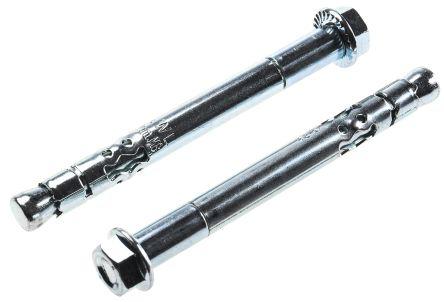M8 Anchor Fixings
If you're a DIY-er, you've probably been looking at different types of m8 anchor fixings but aren't quite sure which to choose. Some anchors are made of Molly bolts, while others are made of Threaded anchors. Others have Snap Toggle bolts or Multi-Fix Thunderbolt bolts. There are pros and cons to using each type of anchor, so read on to learn more about these popular types of anchors and how they work.
Types of M8 Anchor Fixings
Molly bolts
If you are planning to
install a heavy object on a drywall, you should know how to choose the right
type of molly bolt. You can find different types of molly bolts, ranging from
metric to inch measurements. With the proper preparation, you can easily attach
a heavy object to a drywall. In addition, molly bolts come in different
lengths, diameters, and shapes. The hollow wall anchors are great for fixing
heavy objects on a drywall surface.
Molly bolts are
specialized types of wall anchors, with a metal sleeve and a corresponding
screw. Installation requires drilling a pilot hole, and then inserting the
sleeve into the hole. The sleeve expands and locks into the drywall, securing
the item in place. These molly bolts are best suited for small wall-mounted
cabinets, shelves, and towel bars.
Plastic hollow wall plug
anchors are also available. These m8 anchors, sometimes referred to as Molly
bolts, can be installed with a hammer or a drill. Installation requires
drilling a pilot hole before tightening the screw. They are used on light-duty
applications, such as drywall and plaster. In addition to using molly bolts,
you should also be aware of other m8 anchor fixings available.
When installing molly
bolts, you should take care in drilling the hole the molly will fit into. It is
important to use a Phillips/slotted screwdriver for this, as using a hammer
will damage the molly's threads. Afterwards, you should use an expansion clamp
to crimp the molly in the wall. Once the bolt is installed, you should apply a
little pressure to the wall to ensure it is tight against the drywall.
Threaded anchors
The Threaded M8 anchor
bolts are designed to be installed in concrete. The minimum hole diameter for
the bolt is ten millimeters. The M12 anchor bolt requires a 14mm hole diameter
and is suitable for fastening concrete, brick and natural stone. The bolts are
threaded in both directions and have an integrated washer and nut. They can be
used in any situation, including the fixing of glass channel profiles.
A common misconception is
that threaded m8 anchors fixings are incompatible with concrete. However, there are a
number of exceptions to this. The threads are designed to mate with lag screws,
wood screws, and sheet metal screws. These fixings are pre-assembled with a
threaded screw. However, there are some types of anchors that can only be
installed with a specific tool.
The Threaded M8 anchor is
a relatively cheap choice when installing drywall. While they are not as strong
as the plastic expansion anchors, they are still adequate for hanging light
weight items. In fact, some manufacturers are now offering these anchors along
with their products. Moreover, once installed, you can remove them by screwing
the head of the anchor using a 1/4" drill bit. If you do not want to use
them for your project, just drill them out.
Snap Toggle bolts
If you're looking for a
simple, fast and effective way to fasten heavy anchors, Snap Toggle bolts for M8
are the perfect solution. Compared to the usual toggle bolts, they hold twice
the weight of comparable screws in the smallest hole. Plus, they come with
patented, one-piece steel anchoring channels that do not fall behind the wall
when the bolt is removed. They are also easy to install, with a patented
sliding cap that zips down the legs and snaps flush with the surface. And the
legs snap off easily, so you never need to worry about them breaking
prematurely.
With a single-person job,
SNAPTOGGLE can save up to six minutes per anchor, while making the installation
process much faster. It is designed for drywall that's between 3/8" and
2-1/4" thick. Designed for 3-5/8"-thick walls, SNAPTOGGLE bolts can
withstand loads of 238 pounds in 1/2" drywall and 356lbs in 5/8"
drywall. These anchors are also suitable for Grab Bars. Note: the weight values
given are estimates, and the actual performance will depend on the base
material and the strength of the anchor.
Another benefit of
Snap Toggle bolts for m8 anchor fixings is their reusable toggle. Once installed, the toggle
can be removed by simply slipping a wire through the hole and pulling it out
from the wall. The toggle is easily removed and reused, as long as the hole is
large enough. During installation, the surface of the drywall may distort or
tear, but this is normal and should not cause any damage.
When compared to toggle
bolts, TOGGLER toggle bolts are a better choice. Not only are they made of
high-quality 304 stainless steel, but they are easy to install with a screw
gun. In addition to ensuring that your anchor fixings are safe and secure,
TOGGLER toggle bolts save you money and time. And because of their ease of
installation, they are great for single-person installations, saving you both
time and money.
Because Snap Toggle bolts
are stronger than toggles, you won't have to worry about a screw slipping out.
When installed correctly, Snap Toggle bolts can support 25 to 35 pounds of
weight. Moreover, some manufacturers have included them with their products.
Simply screw the screw into the head of the anchor, or drill the head off with
a 1/4-inch drill bit. Then, the anchor will drop into the wall.
Multi-Fix Thunderbolt bolts
Genuine Thunderbolts are
the original self-tapping anchor. They are fully threaded and can be installed
closer to the edge of a building or at varying depths. They are a cost
effective and stress free fix for any job. They can also be removed without
damaging the building's surface and are suitable for a range of construction
materials. And because they are a self-tapping anchor, you can install them
with a standard sized drill bit.
Thunderbolts fixings are
the perfect choice for heavy-duty anchoring jobs. The patented concave thread
allows them to tap into the concrete or brick and offer exceptional pull-out
resistance. They can be used in a wide range of construction materials,
including concrete, stone, brick, wood, metal, marble, and concrete. They are
also suitable for hollow brick. You can find a huge range of Thunderbolt bolts
at your local building supply store or online.
Features
These anchor fixings are
a great choice for commercial and domestic use. General builders and property
developers use them to install handrails on walls and satellite dishes on
roofs. They are extremely easy to use and require no special tools for
installation. They will not damage the building surface and will be able to be
used again. And because of the patented self-tapping action, Thunderbolts are
extremely flexible and are the ideal choice for anchoring many types of
fixtures and anchors.
Unlike ordinary anchors, Multi-Fix Thunderbolt Bolt bolts for anchor fixings are non-expansion and have been tested to 400 hours Spray and three cycles Kessenich for durability. They may come in non-retail packaging. The concave thread enables rapid installation. The bolts may be delivered in non-retail packaging. If you're looking for a fast installation solution, Multi-Fix Thunderbolt bolts are an excellent choice.





Post a Comment